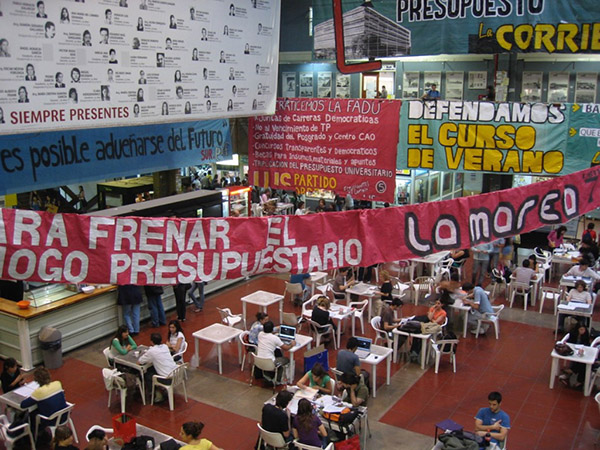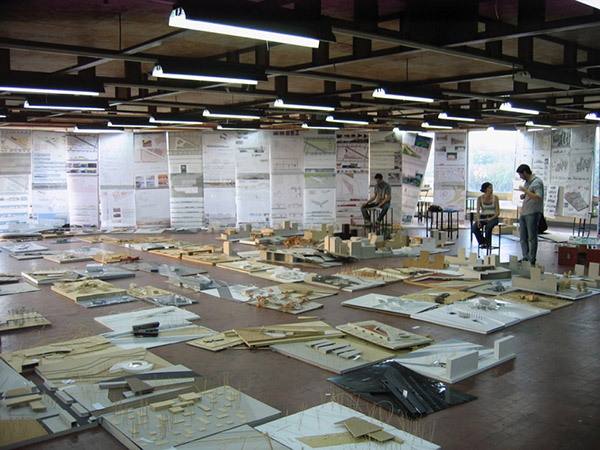Entering the architecture school at the University of Buenos Aires, students pass under a large banner bearing names and photographs of students and faculty disappeared by the military dictatorship of 1976-1983. Together with texts like Arquitectos Que No Fueron (Novillo 2008)—literally “architects that weren’t”—the banner provokes reflection about an unrealized future for architecture that was imagined and then pressed to within an inch of its life over forty years ago. It asks students to consider their inheritance of that moment: to rethink the present through a past substantially shaped by violence, and to hold open the possibility that another architecture is possible. The technical aspects of architectural design—the mainstay of architects’ day-to-day training—were taught in an environment suffused with political inheritance.

A large banner with the names and pictures of students who were victims of state terrorism, in the upper left, hangs over the main hall of the Faculty of Architecture, Design and Urbanism at the University of Buenos Aires. Photo by author.
I arrived at the architecture school to conduct fieldwork for an ethnographic study of a construction boom that followed Argentina’s 2001 economic and political crisis. My current book project, Concrete Dreams, is based on two years of fieldwork with architects, real estate investors, and neighborhood residents, and describes how buildings were incorporated into post-crisis practices of economic investment (see D’Avella 2014), and how other forms of value were made to endure in the face of buildings’ increasingly central place in Argentine economic life.
The architecture school is one of the places where battles over the heart of architecture—and the bodies and souls of architects—have been fought in Argentina. It has been a site of repeated and violent intervention from military governments, and neoliberal reforms that have set out to make architectural education more amenable to market-oriented production. Despite these efforts, however, groups of students and faculty have worked to sustain a vision of architecture that would not be singularly defined by these past and present realities. The architectural school at the University of Buenos Aires is one of the places where the capture of architecture by market logics is placed in tension, where alternatives have been nurtured and the idea of producing vehicles for investment has not always had easy tread.
Architectures of the system and architectures of the people
The workshop where I did fieldwork was run by Juan Molina y Vedia and Jaime Sorín. Juan began teaching in the early 1960s at national universities in the Argentine interior and became known for a pedagogy that placed popular Argentine architecture at the forefront of education. Both of these workshops were shut down in 1966, however, in the violent military takeover known as “The Night of the Long Clubs” that marked the beginning of twenty years of anti-leftist political purges in Argentine universities.
After 1966, much debate within the university was shut down. In response to this attempt to depoliticize architectural education, students in the architecture school organized a group called TUPAU: the Popular University Movement of Architecture and Urbanism, a series of assemblies to rethink the school’s mission for the changing social and political needs of the country. During their seven years of activity, TUPAU issued a variety of pamphlets, position papers, and curricular proposals that were later compiled as the Antología Pedagógica, or “Pedagogical Anthology” (1974). At just over 400 pages, the Anthology is a record of a search for inroads into how to think an architecture for the left in Argentina.
One of the recurrent themes in the Anthology is the question of architecture’s links to capitalist modes of production and the forms of academic inquiry that value it—forces that together produce what the Anthology called the “architecture of the system.” The architecture of the system, TUPAU argued, is “architecture as just another aspect of the market economy. A generator of profit and multiplier of land rent, it is architecture that collaborates in a system of exploitation.” Escaping the architecture of the system was a tall order. Part of the task involved “provincializing,” that is, decentering, European and American avant-gardes. It also required reckoning with architecture’s place as part of commodity culture. The product of architecture, TUPAU argued, is “written into a process of commoditization. In such a society, the architect is limited to the production of obsolescent designs because they are oriented towards the satisfaction of a distorted market, in which capacity for acquisition is restricted to those least in need.”
TUPAU sought to oppose the architecture of the system through a hero that they began to construct: the “architect of the people,” who would “respond to the historical reality of the pueblo.” “We welcome you to a new experience,” TUPAU states in a welcome pamphlet: “the collective experience of a búsqueda [or searching]. This búsqueda is the search for something that we don’t have, that the institutions do not hand out, and that only our struggle could achieve. [Architecture could be] the most beautiful course of study in the world, and also the most horrible. It could lead to the achievement of a vocation, or sale to the highest bidder.” In the face of an architectural culture and educational system steeped in commodity society, dependency, and the universalizing pretensions of Northern avant-gardes, TUPAU sought to create other openings, possibilities held out against probabilities.
In 1973, popular protest won Peronism the opportunity to return to elections for the first time since President Juan Domingo Peron’s overthrow and exile in 1955. Their electoral victory allowed dissident faculty to propose curricular reforms in line with TUPAU’s critiques, including an expanded focus on Argentine history and its articulations with imperialism and struggles for Third-World liberation. Molina y Vedia, shut out of the university for seven years, was asked to lead a new workshop, TANAPO—the National and Popular Workshops—along the lines TUPAU had begun to formulate. At a moment of great enthusiasm for Argentine populism, the workshops reached unprecedented dimensions, with 3,000 students and over 300 faculty participating.
TANAPO was very short-lived, however. Peron’s return was marked by a violent clash between conservative and leftist factions of Peronism, and, following another military intervention in the university, TANAPO, like Juan’s previous workshops, was closed. “They hunted down and killed several of my colleagues,” he told me. Juan went into hiding. Political violence continued after Peron’s death from illness in 1974, and grew into the Proceso, Argentina’s famously brutal dictatorship that disappeared more than 30,000 Argentines, including those whose images overlook the hall of the architecture school today.
Architectural education under the dictatorship would correspond to a more technical image, Juan told me: “they taught with a closed set of criteria, in which a screw is a screw and two plus two is four, to produce minions who don’t think, but who know how to build things that don’t fall and roofs that don’t leak.” Juan would not teach again until the return to democracy in 1985, when he co-founded the workshop in which I conducted fieldwork 23 years later.
Inheriting from TANAPO
Today, Molina y Vedia and Sorín identify as inheritors of TANAPO. Of inheritance, Isabelle Stengers and Philippe Pignarre write that the force of an event is the manner in which it makes the question of its inheritance exist for those who respond to it. “Becoming the child of an event,” they say, is “daring to inhabit the possible” (Pignarre and Stengers 2011).

Professors examine the drawings and models that are the mainstay of architectural education. But architects’ technical knowledge is taught in an environment suffused with political inheritance. Photo by author.
In the workshop, I saw the question of inheritance sit subtly within a pedagogical practice that dared to “inhabit the possible” inspired by TUPAU. There are many stories I could tell, but my mind returns most to a phrase I heard Gaby say to her students: “architecture is for everyone”—a battle cry if I ever heard one against the architecture of the system. I also saw this inheritance in the neighborhoods that were chosen for student projects, outside the typical swath of privilege in which architecture more comfortably dwells: “areas that are not for the market,” as Marta put it to me. And I see it in the programs they select, which include recycling centers for collectives of trash collectors who make their meager living gathering cardboard and bottles.
Other areas of pedagogy were not that different from what one might expect in an architecture school: Mies van der Rohe, Corbusier, Zaha Hadid. Theirs was not a purified architecture of the pueblo, and their work hardly threatened to overthrow the commodification of architecture. But their pedagogy always articulated canonical work in relation to broader questions, putting architecture into the tense presence of worlds where the architecture of the system wasn’t concerned to go. And in that, they worked to lie in the way of a reality in which architecture would be just another commodity, and instead inhabit the possible: that architecture is for everyone.
References
D’Avella, Nicholas. 2014. Ecologies of Investment: Crisis Histories and Brick Futures in Argentina. Cultural Anthropology 29(1): 173–199.
Departamento Pedagógico, Facultad de Arquitectura y Urbanismo, Universidad Nacional de Buenos Aires. 1974. FAU Antología pedadgógica. n.p.
Novillo, Rodolfo, ed. 2008. Arquitectos que no fueron. Córdoba, Argentina: Comisión de Homenaje.
Pignarre, Phillipe, and Isabelle Stengers. 2011. Capitalist Sorcery: Breaking the Spell. Andrew Goffey, tran. Basingstoke, UK: Palgrave MacMillan.
